The Devil is Made of Plastic
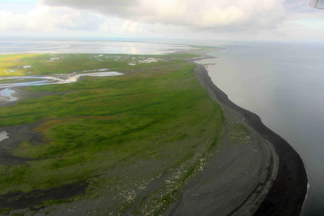
There are over 2,500 miles of coastline in the Kodiak Archipelago, and there are about 3,000-3,500 Kodiak brown bears that call their island namesake home. This means that if all those salmon-stuffed ursas were lined up along the many beaches and bluffs of their Alaskan archipelago each bear would pretty much have its own mile of coast. There are only about 1,300 miles of coastline in the entire west coast of the United States of America, from Bellingham, Washington to San Diego, California, and not nearly that many bears. Think about that one. In July, a team of eight people, myself included, went to Tugidak Island on the southern end of the Kodiak Archipelago and walked a mere 2.5 miles, or one one-thousandth, of Kodiak’s coast, picking up marine debris. Eight to ten THOUSAND pounds of marine debris in three days. Now wrap your head around that number.
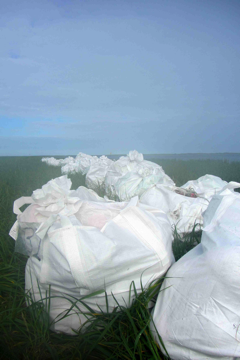 What is marine debris? It’s nothing more than a fancy term for trash. Garbage. Waste. Junk. And on top of whatever your word of choice is for human carelessness, you can also be sure to call it totally destructive and 100% preventable. 100% preventable, really? Yes, friends, as powerless as we all have been conditioned to feel by the forces of destruction themselves (albeit while they are disguised as “clever” advertisements and enticing packaging) this is an environmental problem that we can all stop squarely in its tracks.
What is marine debris? It’s nothing more than a fancy term for trash. Garbage. Waste. Junk. And on top of whatever your word of choice is for human carelessness, you can also be sure to call it totally destructive and 100% preventable. 100% preventable, really? Yes, friends, as powerless as we all have been conditioned to feel by the forces of destruction themselves (albeit while they are disguised as “clever” advertisements and enticing packaging) this is an environmental problem that we can all stop squarely in its tracks.
So what’s the source, you ask, genuinely curious. I recycle (when I can) you say. I don’t live by the ocean and I’ve even adopted a manatee! Well have you ever drunk out of a plastic water bottle? Ever? Even as you gave yourself the excuse that it was only because you left yours at home? Have you ever bought anything that when you turned it over you could feel, in little bumpy letters next to the seam of the plastic, said “MADE IN CHINA,” “MADE IN KOREA,” or “MADE IN TAIWAN”? Have you ever stopped to think about how strange it is for something that originated in a foreign country to have English lettering on it, as clear as day?
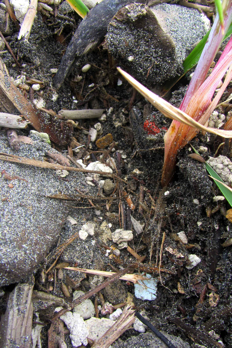 I have seen the devil, and the devil is made of plastic. The devil is every plastic water bottle and every laundry soap bottle and every candy wrapper ever made. The devil is made of Styrofoam. The devil is little foam fishing floats and medium foam basketballs and big foam pieces that help docks stay afloat, but then break down into tiny foam pieces that mix with the grains of sand. The devil is not male or female or natural or good. The devil is a human creation and a manifestation of what we perceive as our tendency to destroy ourselves and our communities and all that is good and natural. The devil (much like the ocean, actually) doesn’t discriminate race, country, or religion; I found lots of washed up bottles that read “MADE IN CHINA” in English, but just as many with actual Chinese characters on them. The idea of the devil is proof enough that given the wrong societal pressures, everyone has the capacity to do evil.
I have seen the devil, and the devil is made of plastic. The devil is every plastic water bottle and every laundry soap bottle and every candy wrapper ever made. The devil is made of Styrofoam. The devil is little foam fishing floats and medium foam basketballs and big foam pieces that help docks stay afloat, but then break down into tiny foam pieces that mix with the grains of sand. The devil is not male or female or natural or good. The devil is a human creation and a manifestation of what we perceive as our tendency to destroy ourselves and our communities and all that is good and natural. The devil (much like the ocean, actually) doesn’t discriminate race, country, or religion; I found lots of washed up bottles that read “MADE IN CHINA” in English, but just as many with actual Chinese characters on them. The idea of the devil is proof enough that given the wrong societal pressures, everyone has the capacity to do evil.
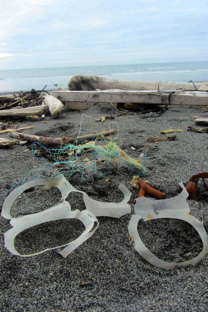 I think about this every time I throw something “away.” There isn’t any “away,” anywhere. For a long time people treated (and still do treat) our ocean like “away,” and this is one source of marine debris, because it turns out that “away” and “far away” are the same thing for most people. And it turns out that most people are also “far away” from my little (or not so little) Alaskan island. And so “away” washes up in droves on beaches that no person lives or walks on, but that seals, and sea lions, otters, and eagles call their home. “Away” tangles them in ropes and six-pack rings. “Away” starves them from the inside out when they think it is food because a square foot of beach contains more pieces of Styrofoam than of visible living creatures. “Away” is not our ocean, not our beaches, and not my backyard. “Away” is a myth to me more than the devil is a myth because I have bought things wrapped in plastic and then thrown away the wrapper, and I therefore know I have the capacity to do bad things.
I think about this every time I throw something “away.” There isn’t any “away,” anywhere. For a long time people treated (and still do treat) our ocean like “away,” and this is one source of marine debris, because it turns out that “away” and “far away” are the same thing for most people. And it turns out that most people are also “far away” from my little (or not so little) Alaskan island. And so “away” washes up in droves on beaches that no person lives or walks on, but that seals, and sea lions, otters, and eagles call their home. “Away” tangles them in ropes and six-pack rings. “Away” starves them from the inside out when they think it is food because a square foot of beach contains more pieces of Styrofoam than of visible living creatures. “Away” is not our ocean, not our beaches, and not my backyard. “Away” is a myth to me more than the devil is a myth because I have bought things wrapped in plastic and then thrown away the wrapper, and I therefore know I have the capacity to do bad things.
Now, I don’t want your pity parties. I know this doesn’t make me a “bad” person by standard definitions, but I don’t want to gloss it over either and make excuses about it. Every time I have to put something in the trash or I see someone else put something in the trash I feel an almost physical discomfort about it. It makes me mad and it makes me sick how much my society throws “away.” Now imagine what would happen if everyone felt this way, and was conditioned with compassion and not with corporations. This is the world I try to create. This is the world I have to believe is possible so that I can wake up every day and try to make my small ounce of difference. But I know that this world is possible, and it is happening. It requires you. All of you. We’re in this together because together is the only way to be.
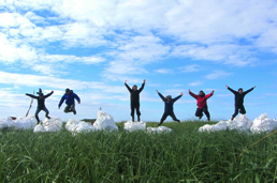 Together we can do great things; this I also know. I may have hauled nearly 1,000 pounds of trash in three days, but together with the rest of the Kodiak Refuge Youth Conservation Corps crew, our supervisor Shelly, a Refuge intern named Randall, and employees and volunteers from the Kodiak nonprofit Island Trails Network, we picked up almost 10,000 pounds in 3 days! Was it depressing to be able to sit in the beach grass just above the tideline and move in a 5-foot radius for upwards of ten minutes just picking up little tiny pieces of Styrofoam? Yes. It made me want to scream. Was it sad to find a plastic packing strap wrapped around a log that could just as easily been a seal’s throat, and then not two minutes later see a curious seal head pop above the waves? Absolutely. It made me want to cry for all the sea animals who were not as lucky as that one. But was it inspiring to know how much of a difference we made? Without a doubt. It made me want to dance for joy. It made me enjoy the beautiful beach we camped beside and fall asleep happy to the sound of the crashing waves.
Together we can do great things; this I also know. I may have hauled nearly 1,000 pounds of trash in three days, but together with the rest of the Kodiak Refuge Youth Conservation Corps crew, our supervisor Shelly, a Refuge intern named Randall, and employees and volunteers from the Kodiak nonprofit Island Trails Network, we picked up almost 10,000 pounds in 3 days! Was it depressing to be able to sit in the beach grass just above the tideline and move in a 5-foot radius for upwards of ten minutes just picking up little tiny pieces of Styrofoam? Yes. It made me want to scream. Was it sad to find a plastic packing strap wrapped around a log that could just as easily been a seal’s throat, and then not two minutes later see a curious seal head pop above the waves? Absolutely. It made me want to cry for all the sea animals who were not as lucky as that one. But was it inspiring to know how much of a difference we made? Without a doubt. It made me want to dance for joy. It made me enjoy the beautiful beach we camped beside and fall asleep happy to the sound of the crashing waves.
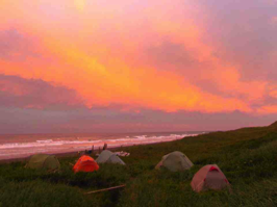 The key is how you measure and appreciate the act of making a difference. Because there is no “away,” all of the trash we picked up will still exist. Some will be recycled, but some will simply sit in a landfill instead of the precious habitat it was in that still exists in close to its natural state. More trash will eventually wash up. Unless. Unless we stop it at the source. No more marine debris will ever wash up on that beach on Tugidak Island or any other beach for that matter if everyone in the world decides that we don’t want to live in a society that consumes and “disposes” of such vast amounts of resources so thoughtlessly. And that society starts with us. With the story I am telling you and that you can tell to other people. With the girls I work with in the Youth Conservation Corps that completely changed their minds about using plastic in three short, but beautiful days.
The key is how you measure and appreciate the act of making a difference. Because there is no “away,” all of the trash we picked up will still exist. Some will be recycled, but some will simply sit in a landfill instead of the precious habitat it was in that still exists in close to its natural state. More trash will eventually wash up. Unless. Unless we stop it at the source. No more marine debris will ever wash up on that beach on Tugidak Island or any other beach for that matter if everyone in the world decides that we don’t want to live in a society that consumes and “disposes” of such vast amounts of resources so thoughtlessly. And that society starts with us. With the story I am telling you and that you can tell to other people. With the girls I work with in the Youth Conservation Corps that completely changed their minds about using plastic in three short, but beautiful days.
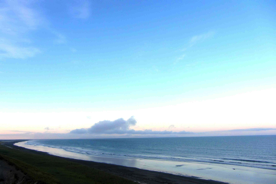 One evening after a full day of picking up trash, myself and the other team members and volunteers were walking back along the beach towards camp, having left our collected garbage in piles above the tideline for another team member with a 4-wheeler and a trailer to pick up and bring to a site farther up the coast where a landing-craft will pick it up at the end of the summer. One of the girls I work with on the Youth Conservation Corps, Ruby, and I were walking beside each other, just enjoying the smell of the seaweed and the way the sun was still so high and hot despite it being six in the evening. Before joining the Youth Conservation Corps, Ruby had never been anywhere as remote as Tugidak, and in order to get to the stretch of beach we cleaned up we had traveled by floatplane, 4-wheeler, and foot. As our feet walked back past the piles of fishing line, buoys, and plastic we had cleaned up earlier in the day, Ruby and I talked about the plastic and what would happen to it after it was picked up.
One evening after a full day of picking up trash, myself and the other team members and volunteers were walking back along the beach towards camp, having left our collected garbage in piles above the tideline for another team member with a 4-wheeler and a trailer to pick up and bring to a site farther up the coast where a landing-craft will pick it up at the end of the summer. One of the girls I work with on the Youth Conservation Corps, Ruby, and I were walking beside each other, just enjoying the smell of the seaweed and the way the sun was still so high and hot despite it being six in the evening. Before joining the Youth Conservation Corps, Ruby had never been anywhere as remote as Tugidak, and in order to get to the stretch of beach we cleaned up we had traveled by floatplane, 4-wheeler, and foot. As our feet walked back past the piles of fishing line, buoys, and plastic we had cleaned up earlier in the day, Ruby and I talked about the plastic and what would happen to it after it was picked up.
“But,” she said to me at one point, “is recycling really so great? Won’t it just get turned into more plastic?”
“Yes,” I said, “Unfortunately you’re right. Recycling is not really the answer either.”
And it isn’t. Now, it’s better than nothing of course, so by all means don’t stop recycling. Recycle everything and anything you can. 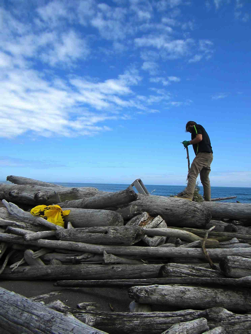 But first consider that recycling should be our last, not first, act of environmental consciousness. What I mean by this is that out of the little mantra “Reduce, Reuse, Recycle,” recycling really should come only after we have reduced and reused as much of our “waste” as absolutely possible. Better yet, I like the five R’s that my supervisor Shelly uses: Rethink, Refuse, Reduce, Reuse, Recycle. This mindset, plus a sixth R that I added myself, I think is the key to changing the world with the way you live.
But first consider that recycling should be our last, not first, act of environmental consciousness. What I mean by this is that out of the little mantra “Reduce, Reuse, Recycle,” recycling really should come only after we have reduced and reused as much of our “waste” as absolutely possible. Better yet, I like the five R’s that my supervisor Shelly uses: Rethink, Refuse, Reduce, Reuse, Recycle. This mindset, plus a sixth R that I added myself, I think is the key to changing the world with the way you live.
Rethink your relationship with the stuff you have and what you really “need.” Imagine that plastic is the enemy and avoid “disposable” objects and packaging whenever possible. Also know that “whenever possible” is a lot more often than you think. Don’t make excuses.
Refuse to be anything less than grandly and inspiringly idealistic. What fun would it be otherwise? Refuse plastic or paper bags in stores and bring your own. Refuse to use any and all other disposable items, such as paper coffee cups. Forgot your reusable one at home today? Refuse to allow yourself to make the excuse.
Reduce the amount of resources (plastic, oil, wood, metal, etc.) you consume in the first place. Share things! Go on walks! Save your money for nice things that you really need and nice food with no packaging.
Reuse anything and everything. The sky is the limit! Dare to be creative and be proud when your nifty reuse ideas catch on. If you can’t reuse it, try finding someone who can or who can teach you how.
Recycle everything that is left. Can’t recycle it? Consider how it entered your life and how to eliminate “consuming” it in the future.
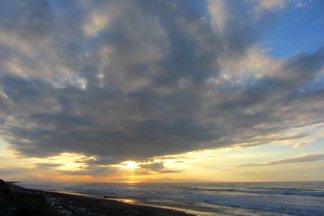 Respect (my R!) Respect yourself. Respect your community. Respect the Earth. Respect the eagles and the seagulls and the seals and the sea otters. Respect the beauty of nature and the wonder of life. Live with awareness and compassion. Find something in your life that you love as much as I love crashing waves on driftwood-strewn beaches and how the ocean’s salty exhale floats and dives on the on the wind and protect that thing you love at any cost. Protect your right to love it with the way you live every single moment of every single day of your life. Your love is power, and you have the power to make a huge and appreciated difference. In the fight between good evil, love always wins.
Respect (my R!) Respect yourself. Respect your community. Respect the Earth. Respect the eagles and the seagulls and the seals and the sea otters. Respect the beauty of nature and the wonder of life. Live with awareness and compassion. Find something in your life that you love as much as I love crashing waves on driftwood-strewn beaches and how the ocean’s salty exhale floats and dives on the on the wind and protect that thing you love at any cost. Protect your right to love it with the way you live every single moment of every single day of your life. Your love is power, and you have the power to make a huge and appreciated difference. In the fight between good evil, love always wins.
Peace, love, and the ocean, from Kodiak, Alaska,
Leila Pyle
Tags: kodiak national wildlife refuge, plastic, education, conservation
